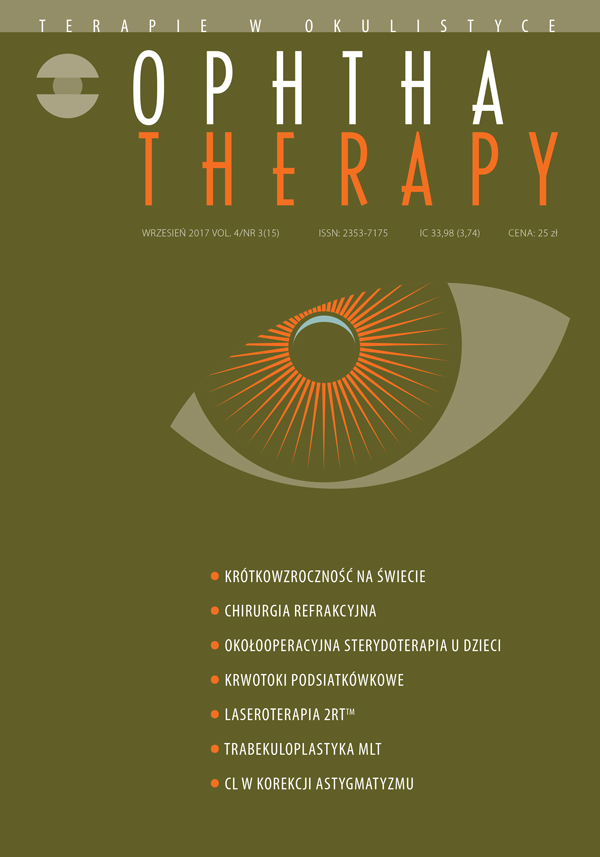Is it possible to avoid the use of steroids drops after cataract surgery in children?
Main Article Content
Abstract
The paper aims at comparing postoperative reactions in children after cataract surgery, in whom either steroid drops were used or intraoperative subtenon methylprednisolone injections were performed. The study involved 40 children operated on for cataract. In 20 of them, subtenon methylprednisolone injections were performed while on the operating table, with no steroid drops prescribed to be used in the postoperative period. In the remaining 20 patients, on the other hand, steroid drops were administered for 30 days. In both groups, antibiotic was used in the form of drops for 7 days. All patients underwent assessment in terms of their postoperative wound healing, inflammatory reactions, number of inflammatory cells in the anterior chamber, bodily changes, and intraocular pressure. The study indicated that postoperative reactions and intraocular pressure were comparable in the two groups, whereas the inflammatory reaction within the anterior chamber was resolved more quickly with the help of injections. Intraoperative subtenon methylprednisolone injections are thus considered equally effective in postoperative reaction inhibition as steroid drops instilled in the conjunctival sac. The new method makes it possible to avoid the postoperative use of steroid drops that are poorly tolerated by children and prove to be an additional psychological burden for the parents.
Downloads
Article Details

This work is licensed under a Creative Commons Attribution-NonCommercial-NoDerivatives 4.0 International License.
Copyright: © Medical Education sp. z o.o. License allowing third parties to copy and redistribute the material in any medium or format and to remix, transform, and build upon the material, provided the original work is properly cited and states its license.
Address reprint requests to: Medical Education, Marcin Kuźma (marcin.kuzma@mededu.pl)
References
2. Zierhut M, Deuter C, Murray PI. Classification of uveitis – Current guidelines. European Ophthalmic Review. 2007; 1: 77-8.
3. Flaxel JT, Swan KC. Limbal wound healing after cataract extraction. A histologic study. Arch Ophthalmol. 1969; 81: 653-9.
4. Kessel L, Tendal B, Jørgensen KJ et al. Post-cataract prevention of inflammation and macular edema by steroid and nonsteroidal anti-inflammatory eye drops. A systematic review. Ophthalmology. 2014; 121: 1915-24.
5. Alizadeha R, Jabbarib SM, Zarnanib AH et al. Synthesis of Depo-Medrol–chitosan hydrogel as new drug slow release appliance and investigation of release kinetics by highperformance liquid chromatography. Biomed Chromatogr. 2016; 30: 1346-53.
6. Jachowicz R, Jamróz W. Biofarmaceutyczne aspekty podawania leków do oczu. In: Prost M, Jachowicz R, Nowak JZ (ed). Kliniczna farmakologia okulistyczna. Wyd. 2. Edra, Urban&Partner, Wrocław 2016: 12-24.
7. Charakterystyka Produktu Leczniczego, Depo-Medrol, 40 mg/ml, zawiesina do wstrzykiwań. Urząd Rejestracji Produktów Leczniczych, Wyrobów Medycznych i Produktów Biobójczych w Warszawie. http://leki.urpl.gov.pl/files/25_DepoMedrol_zaw_do_wstrz_40mg_ml.pdf.

